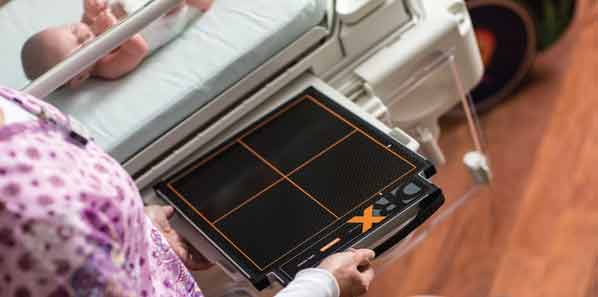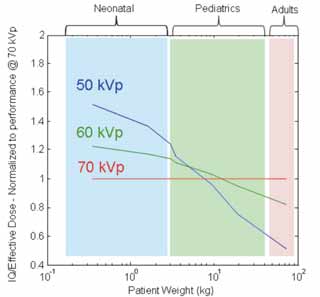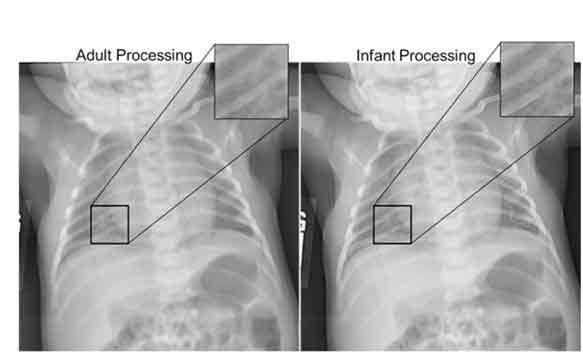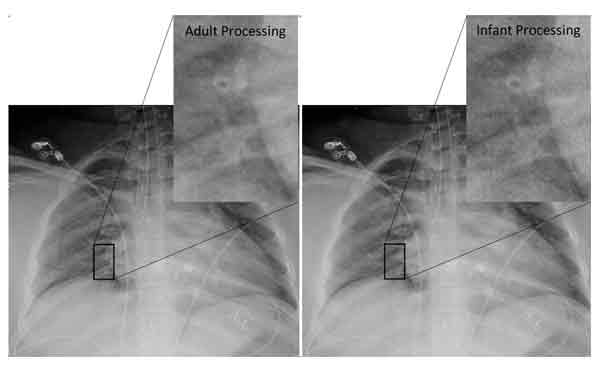HealthManagement, Volume 14 - Issue 2, 2014

The importance of minimising radiation dose to paediatric patients while maintaining image quality has come to the fore in recent years. Children and infants have a range of body types. Their organs and bones are still growing and are therefore more sensitive to ionizing radiation. Their long expected lifespan also requires close attention to radiation dose in order to minimise risk. The Image Gently® campaign of the Alliance for Radiation Safety in Pediatric Imaging, which is supported by Carestream Health, is channelling efforts to educate everyone involved, from radiologists, physicists and radiographers to parents and referring physicians, on the need to adjust radiation dose when imaging infants and children. The Image Gently® campaign’s “Back to Basics” initiative encourages the use of child-specific imaging practices in digital radiography.
One size does not fit all, and the need to adjust dose and review quality in paediatric imaging is apparent throughout the imaging process. It is not appropriate to use the same acquisition techniques and image-processing parameters as for adults. Parents and their children deserve the best quality image at the lowest possible dose.
The unique demands of paediatric imaging require a system wide approach to guarantee high-quality imaging at the lowest possible patient exposure. Carestream Health‘s products can assist in all stages of the process of acquiring and displaying images for diagnosis, and offer a range of features and functionality to provide the best and safest possible X-ray imaging across the full clinical range of exams for all paediatric patients.

Figure 1. Flow diagram for the image-formation process, including review and assessment and feedback on quality
Optimising Image Acquisition in Digital Radiography
The first stage in getting the image is to capture the X-ray image with an efficient detector using the appropriate acquisition protocols (e.g. kVp, mAs and filtration) across the wide range of paediatric body types. In digital radiography, Carestream offers a range of innovative, freestanding, wireless DRX detector products.
Advantages
• CsI(Tl) X-ray absorption layer helps to ensure highest possible image quality;
• Wireless design eliminates hazards and risks from cables and reduces infection risk; virtually eliminates issues with patient positioning in a busy clinical environment, and does not disrupt the workflow of neonatal and paediatric ICUs;
• Replaceable battery guarantees that the detector is ready to use immediately;
• Paediatric Capture Image Optimisation & Enhancement Software offers default acquisition parameters and unique image-processing for seven age/weight categories for patient body size (from very low birth weight to adolescent) appropriate for different detector types, based on FDA recommendations.
Research into Acquisition Techniques
Carestream is continuing to research and develop improved acquisition techniques for paediatric patients. Use of a digital receptor means it is possible to target a specific signal-to-noise ratio in the image, versus maintaining a specific optical density in the final image. Separation of acquisition and display of a digital image offers the opportunity to develop task-specific tailoring for the amount and type of radiation used to create digital images.

Figure 2. Shows a normalized image-quality metric (detectability index per unit of effective absorbed dose) for a 5-10mm sized lung nodule, as a function of patient weight. The results are normalized to those for the 70kVp technique, and show that for lighter patients, a lower kVp can provide improved image quality for a given patient dose, while higher kVps are more beneficial for larger patients.
In some procedures, such as scoliosis exams, it may be possible to reduce the exposure levels used for follow-up images. Exposure reduction works if the imaging task can be achieved with an image that is noisier than the high-quality primary exam, but still provides sufficient delineation to allow accurate clinical evaluation. In the example of scoliosis, Carestream Health has also implemented a long-length imaging capability that minimises the amount of overlap between consecutive images, thus reducing patient exposure and ensuring maximal coverage of the anatomical field of view.
Image Preview and Radiation Amount
Rapid display of the preview image allows the radiographer to quickly decide whether the patient’s anatomy was correctly captured or if the image needs to be retaken. This improves speed and efficiency in completing exams, which is particularly important for young patients. To help, Carestream has implemented the IEC Exposure Index (EI) standard for quick assessment of the amount of radiation used to create the image. The Deviation Index (DI) allows an immediate evaluation of the acquisition technique compared to the institutional target of exposure for the given exam. This immediate feedback, coupled with the other developments in technique selection described above, helps the radiographer provide more consistent image quality.
Optimising Image Processing and Display
The next step is to perform appropriate image processing that presents the diagnostic information clearly and most efficiently to the radiologist. Carestream's EVP Plus Software can be tailored to adjust the image-processing parameters to an individual site’s preference. With information about the patient’s size and age, the IP parameters can also be adapted to display the features of the clinical information in a more informative way compared to using adult image-processing configurations. The eight-band frequency decomposition, multi-frequency noise reduction and controlled edge-restoration capabilities mean that the available clinical content of the bony structures in the smallest NICU patients can be appreciated as well as the trabecular detail of older more developed patients, for example. The fine detail and lower contrast of the smallest NICU patient’s anatomy requires accentuation of different frequency components than the features of the larger adolescents.

Figure 3. An infant chest image processed with both adult (left) and infant (right) image processing. Note that many infant chest details are not apparent when using adult processing.

Figure 4. A teenage chest image processed with both adult (left) and infant (right) image processing. Note that fine details of the teen chest are overemphasized when using infant processing.
Quality Control
A continuous quality control (QC) programme is essential to maintain delivery of high quality images. Carestream Health has implemented a number of imaging system capabilities that enable a site to easily track key quality criteria.
Software Tools
To test digital radiography (DR) and computed radiography (CR) quality, Carestream Health offers the Total Quality Tool (TQT) package. The package includes test phantom kits, and enables efficient evaluation of the digital X-ray detector’s current performance level. The IEC Exposure Index allows quick evaluation of the exposure levels used to acquire the images. The Deviation Index immediately compares the exposure used to the institution’s target. Dose Reporting sends data on total dose back to the RIS, including rejects. The Administrative Reporting and Analysis Software enables queries on all Carestream systems across the institutional network from a single, central location. This can quickly highlight anomalous exposure levels, high repeat rates or other image quality issues, and allows for more proactive steps to solve potential problems. Together, these system capabilities can help technologists maintain their high level of image quality and consistency.
Product Information
Small format DRX 2530C Detector (including Paediatric Image Optimisation & Enhancement Software) – fits easily into a neonatabl incubator X-ray tray
DRX-Revolution Mobile X-ray System – includes child-friendly graphics
For more information visit carestream.com/pediatrics
About Carestream Health
Carestream is a worldwide provider of dental and medical imaging systems and IT solutions; X-ray imaging systems for non-destructive testing; and advanced materials for the precision films and electronics markets—all backed by a global service and support network. For more information about the company’s broad portfolio of products, solutions and services, please contact your Carestream representative or visit www.carestream.com
To view Carestream’s latest news announcements, please visit www.carestream.com/news

